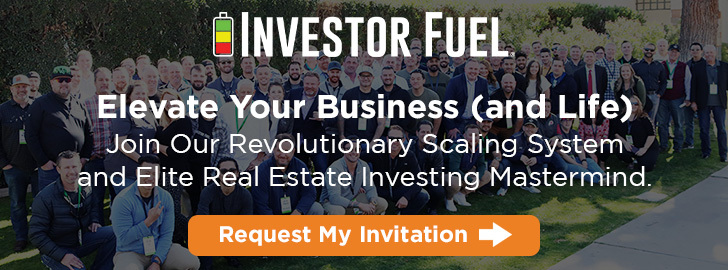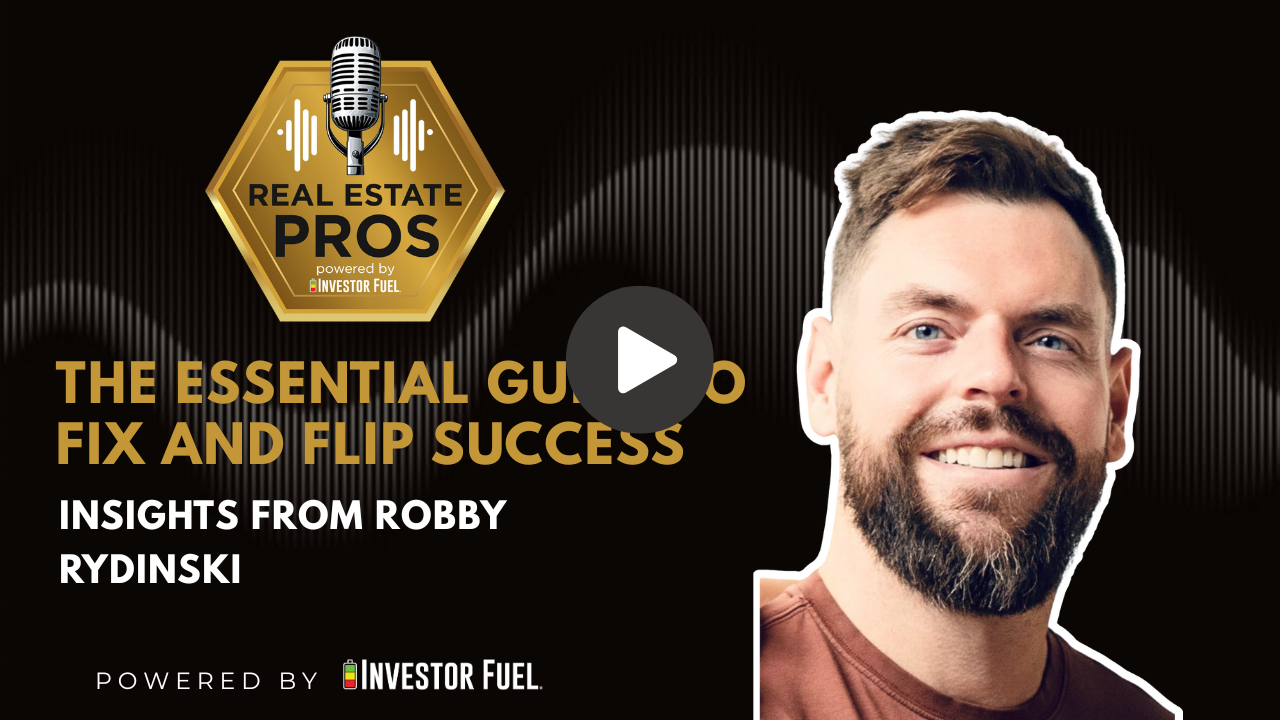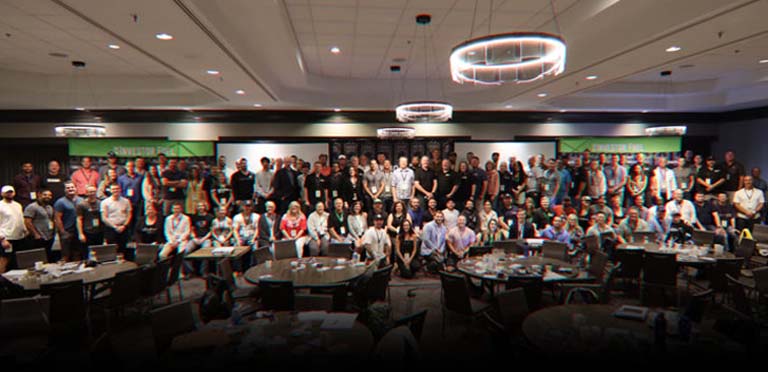
Show Summary
In this conversation, Dylan Silver interviews Robby Rydinski, a seasoned professional in the real estate and financial services industry. Robby shares his journey from FinTech to real estate lending, discussing the evolution of Anchor Loans, the intricacies of the fix and flip market, and the challenges faced by real estate investors. He emphasizes the importance of understanding the numbers in real estate investing and the need for lenders to be flexible and supportive partners. The discussion also covers niche markets in real estate lending and identifies hot markets for fix and flips across the country.
Resources and Links from this show:
Listen to the Audio Version of this Episode
Investor Fuel Show Transcript:
Dylan Silver (00:00.884)
Hey folks, welcome back to the show. I’m your host, Dylan Silver. And today on the show I have Robby Rydinski. Robby is a seasoned professional in the real estate and financial services industry, specializing in new construction, fixed inflip projects, development and rental financing for experienced real estate investors. With a career spanning over a decade, Robby has established himself as a prominent figure in the business purpose lending sector, consistently delivering
results, reliable communication, aiming to exceed expectations. Robby, welcome to the show.
Robby Rydinski (00:38.892)
Yes, sir. Thanks for having me.
Dylan Silver (00:41.342)
I always like to start off at the top of the show by asking folks how they got into the real estate space.
Robby Rydinski (00:48.462)
Well, I actually got into FinTech first. I got into a company called Lending Club, which is peer-to-peer lending for unsecuredized credit card consolidation debt. They were kind of the first to have people on the street investing in loans that they could get a return on. And then it was just a big marketplace for financial technology.
Exchanges so i really wanted to get into that because i studied finance and in college so i did that we got to see that company go from. know again all on one floor in san francisco to ipo so we got to see a financial technology go to scale. I just love that i couldn’t get enough of that i went into more of like. I was operations when i was over there.
And then I got more into sales and doing that. And one of my buddies actually got a job at lending home at the time is now it’s now Kiavi. But I got a job over there and fell in love with real estate lending and just the operators that we got to work with, the brokers that we got to work with, help scale their business. There’s a lot of intricacies. The first 12 months of lending money to real estate investors was a very big learning process for me.
But after that, just keeps compounding into new stuff, new opportunities, new way to structure deals, having that big macro insight of what these investors are doing to help them originate the loans. just, I couldn’t get enough of that. So financial technology was really, really what got me into where I got to at Lending Home Kiavi, because they use the technology.
software and website to streamline hard money lending. And now I’m over at a company called Anchor Loans, just doing big, loans and running a big team over here. And it’s been great.
Dylan Silver (02:56.604)
It seems like you’re the Swiss army knife of building great teams.
Robby Rydinski (03:00.684)
Yeah, yeah, I’d like to think so. I’ve been a hustler the first eight years of my career and now I’ve kind of transitioned into like a CEO role and I’m really, and I’ve learned I’m really good at it. My team is really good. They have all the same attributes that I have had that have led me to be successful in my career. The communication, the problem solving, it’s more than just originating alone. It really is, it’s just.
If you can have that extra level of detail and understanding, you’ll provide that insight to your customers and they’ll have a great experience and it just snowballs.
Dylan Silver (03:42.25)
Let’s talk about that level of detail. So Anchor, is it fix and flip loans?
Robby Rydinski (03:46.798)
Yeah, it’s fix and flip. It’s construction, heavy construction. That’s really what we’re best at. We do development stuff, bridge loans. So the guys that really are buying lots, they’re splitting lots. They want to go ground up on all those, making a little development. Even the big ones, we have a division of our company now, Anchor Home Builder. So we’re lending $50 million development deals over there, but…
Bread and butter is definitely the single asset, fix and flip and ground up construction. We can do portfolios in that too. That’s kind of what we’re the best at.
Dylan Silver (04:28.756)
There’s a lot of people in this space, the lending space. There’s a lot of options and right now with everything that’s at people’s fingertips, people can go across state lines and now they have a national entity, right? And so I could be borrowing from someone based out of New York and vice versa. And with so many options, you mentioned detail, right? Why anchor loans?
Robby Rydinski (04:36.844)
Right.
Robby Rydinski (04:51.266)
Yeah, I mean, it’s saturated. This is a very saturated industry from when I got into it 10 years ago. Even when I got into it 10 years ago, starting at Kiavi, lending home, there was a lot of learning to understand how to do this better. Now, everyone has a pretty good baseline level of like, we can all do this really good. And it’s all about the service and being there.
with rates and leverage. If you’re too far outside of that, you know, this is a bottom line business. It really is. You have to be close because everyone’s trying to save money on their investments. They borrow money as a necessity to scale. And if they’re doing it 15 at a time, that adds up quite heavily. And those are the ones that we are really good at servicing. So Anchor’s a good lender partner, helps service.
multiple loans, even when it gets to the servicing stage of, we’re past maturity. There’s a lot of lenders that really don’t have the flexibility to extend it more than once or even extend it for a low fee, right? You’re a product of whatever the machine can support. We have a lot of different capital outlets to where we’re able to extend loans easily. We’re really good at construction, like I said, so our draws are very seamless and
It caters to the real estate investor. Anchor’s been around for a long time, 25 years, it’s not like, you know, we haven’t originated a loan and understand and formulated our program and process to support a lender partnership rather than a loan originator, if that makes sense.
Dylan Silver (06:22.208)
Hmm.
Dylan Silver (06:34.976)
Can we go granular here for a sec? So you talked about extending a loan, And when I think about fix-up, I think about there’s deadlines, people have things that come up, there may be more issues, right? Or, you know, the home’s not selling, right? There’s all these…
Robby Rydinski (06:36.696)
Yeah, let’s do it.
Dylan Silver (06:52.288)
factors that come into play. haven’t done a fix and flip myself, but I participated as a a literal worker on a fix flip, right? Just to see kind of, okay, this is how you you know, take out subfloor. This is what a bad foundation looks like. This is the things that you have to, you know, come across. Here’s wiring issues, so on and so forth. And so when you talk about extending, is this these kinds of issues like these, the property sitting on market or, or, you know, it’s it’s it’s a
Robby Rydinski (06:58.659)
Yeah.
Robby Rydinski (07:16.194)
Correct.
Dylan Silver (07:19.616)
more and more in repairs than we initially thought.
Robby Rydinski (07:22.392)
Correct. Yeah. mean, think about it at scale, right? I’ve, I’ve alluded to this multiple times of like, we want to be a good lender partner and we are really good lender partner for the scaling real estate investor. And the amount of reps, the amount of properties that the scaling real estate investors take down, there’s going to be some losers in there. That’s just a part of real estate investing. You can’t anticipate every single one of them is going to be.
the best is going to be tenants in them. There’s going to be the foundation issues. Like you said, there’s going to be the ones that just sit on the market, right? Like they missed on their numbers. They missed on their comps. It just happens. That’s part of it. So when you get to your 12 months, you have to extend the loan. These are short term interest only bridge loans that are the fix and flip. The construction ones are a little bit longer, 18 months. We can get up to 24, but
You can’t anticipate unforeseen issues that arise with real estate investing, just people in general, some break-ins, some fires. You just don’t know. And having the flexibility on the back end to be like, all right, look, we’re just gonna increase your rate 1%, no fees. That’s kind of what we like to do to help them finish. There are…
a lot of other lenders in the space that don’t have that flexibility. They’re like, look, our loan docs say this is a 1 % fee for three months. This is a 2 % fee for six months, right? And they’re like, well, wait, I paid half a point to originate the loan on the front end and you’re gonna charge me two points on the backend to extend this six months. We’re talking big loans here. Like if we’re talking million dollar loans, that’s a big chunk just to get, you know, three to six months extension, right?
and that eats into the profit again. And it’s not, it’s not a matter of like the lenders trying to, that they’re trying to be, you know, shitty to the, to the investor. That’s not what they’re trying to do. They’re just the machine that they’ve built supports doing 12 months or 18 months and not extending past that multiple times. So it’s, it’s not a fault of anyone other than the way that the, the entire organization is built to support.
Dylan Silver (09:32.446)
Y’all know.
Robby Rydinski (09:42.126)
scaling real estate investors. you know, no one wants to do that. No one wants to continue to extend loans. It’s not what any investor doesn’t want to either, right? But there is the reality when reality hits that 12 month mark and it’s like 1.2 points, three points to get it extended when we’re like, look, we’re just going to add 1 % to the rate. You’re going from a 9 % rate to a 10 % rate. Your monthly payments going to go up a little bit. You need to get out of the deal. That’s, that’s pretty, that’s a pretty big deal, right?
Dylan Silver (09:43.744)
You know, I’m…
Well… Either.
Dylan Silver (10:09.984)
Yeah. Yeah, that’s a lot that’s gonna play there. 12 months from now.
Robby Rydinski (10:14.03)
It’s something you don’t think about, right? You’re originating a loan today and you’re like, shit, 12 months down the line, I’m running into a big problem and it’s on three properties and those three properties are ruining all my profits for the rest. And when it comes to tacking on more fees and more stress and more headache, like it’s easy to get lured in by, you know, the half a point, 8 % rate, 9 % rate or whatever it is, a hundred percent financing. That’s, that’s the easy part to get lured in, but
If you think about holistically, I need to scale my business with someone who understands the business, number one, and two, who can like think about potential issues. And like I said, I’ve been doing this for 10 years. So I’ve seen the cycles of guys doing 20 a month with me. And then all of a sudden they’re getting, they’re getting screwed on the back end due to problem properties, problem tenants, problem with extensions.
Dylan Silver (11:10.016)
Robby, let’s pivot a bit here and talk about driving growth and organizational growth. And you became a part of Anchor, you mentioned, not when they were just created, but you’ve helped expand them to the role that you are in today. then at your previous year,
Robby Rydinski (11:25.954)
Yeah, yeah, yeah. V2. V2 of Anchor.
Dylan Silver (11:29.054)
your previous company, you saw them go from where they were at to an IPO. Now, as someone who’s an operator in the space, oftentimes we don’t take a step back and reflect on the things that we’re doing well. But in talking with you, it’s clear that there’s some leadership acumen. It’s clear that there may be some intangibles. If you were to give someone else advice for someone stepping into a role that maybe you stepped into in any of these organizations, are there any key takeaways that you would tell people that really help spur your success?
Robby Rydinski (11:57.986)
Yeah. Are you referring more to like as an originator stepping into like getting into the space and lending money to real estate investors? Are you talking about the operator specifically about them going out and trying to tackle real estate investing as their business as an originator? I mean, it’s very it’s very hard in the beginning to say no if it doesn’t work, if it doesn’t fit. If you are understanding like
Dylan Silver (11:58.93)
you
Dylan Silver (12:13.696)
as an originator, as an originator.
Robby Rydinski (12:27.202)
the capabilities of your lender that supports your business and you’re trying to fit deals that don’t fit that and you’re spinning your wheels on that, you just got to learn to say no a lot of the times. And that’s really hard as someone starting because, you know, a bird in the hand is better than two in the bush, right? That old saying. But at the same time, that bird in the hand is going to cost you four days when you could have been
Dylan Silver (12:44.511)
Yeah.
Robby Rydinski (12:55.586)
hitting people and just being very intentional with your approach saying, look, we’re really good at single asset fix and flipping ground up construction. If you’re getting, you have those type of deals, let’s talk, let’s look at them and let’s try, if I’m not right on price, let me compete for that. That’s what you need to do. Figure out your avatar, your client, your target and stick with that. Don’t try to get too far off and
You can say, look, if you’re doing developments, we don’t do that. You should try Vizio. You should try Lima. You should try Genesis. You should try someone else in the space. But we can’t do that really well. Next time you got a fix and flip or a ground up, hit me up and let’s look at those.
Dylan Silver (13:43.902)
Robby, you were building Anchor in the earlier days to where it is today, and you’re of course seeing the landscape change now drastically with everything that we have at our fingertips now versus then, and it was a lot then too, was there a set criteria that you would have that has changed over time when evaluating deals and when evaluating people that we’re looking for for fix and flip loans?
Robby Rydinski (14:00.472)
Yeah.
Robby Rydinski (14:13.804)
Yeah, are you talking more about like early days at Lending Home Kiabi or like right when I got to anchor in the last 12 months?
Dylan Silver (14:20.564)
right when you got to anchor.
Robby Rydinski (14:22.318)
So yeah, it’s the same approach, honestly. Like I was rebuilding a book of business and I just needed to be the same type of intentional and figure out what Anchor does really well and try to mold my and pivot my approach to investors in that sense. again, we’re really good at ground up construction and luxury fix and flips, like doing big ones in LA.
or any of the other big metros around the United States. Yeah, we’re really good at the luxury stuff and people don’t like other lenders don’t love playing in that three to 10 million. Like we just increased our max individual deal size to 20 million. So that can support those crazy luxury builds. And that’s where I’ve kind of pivoted my business and my pitch and my approach to like
Dylan Silver (14:51.872)
Hmm.
That’s a niche, yeah.
Robby Rydinski (15:21.376)
Again, just do what we’re good at. That’s what it’s about. That’s what you gotta do as an originator. Not try to make everything work. Figure out what works really well and what the company wants to support and go after it. Just get after that target audience.
Dylan Silver (15:24.0)
Yeah, I think it’s.
Dylan Silver (15:37.076)
think it’s very easy to take a look at all the things that you have the ability to do and maybe the capacity to do on some level and you mentioned like luxury fix and flips right that right there I’m like there’s a niche you know because I’m in Dallas you know and there’s there I don’t I can’t name a luxury lender for high dollar no one right and so it’s like when when I have
Robby Rydinski (15:51.704)
Right, it’s a niche, right? Yeah.
Robby Rydinski (15:58.094)
Yeah, he’s doing that, no one. No one’s doing that.
Dylan Silver (16:03.9)
Someone let’s say out here who say hey Dylan. Do know anybody who does?
luxury fix and flip lending, can say, well, yeah, actually, I do. Right. And so it’s tempting. It’s very tempting to say, hey, well, we’re going to do a little bit. You mentioned development, right? It’s tempting to say, you know, we’re going to lend in multiple different avenues into multiple different avatars versus, hey, this is what we’re going to laser focus in on. And beyond that, I actually think that’s applicable to real estate operators as a whole, whether you’re on the lending side, or if you’re like me and you’re a wholesaler and a realtor, I’m tempted.
Robby Rydinski (16:12.832)
Yeah, yeah, yeah.
Robby Rydinski (16:26.168)
Yeah.
Robby Rydinski (16:33.762)
It is.
Dylan Silver (16:39.05)
the time to be like hey let me get a fix and flip for myself and lately I’ve been saying hey I’m a good wholesaler and I’m a new realtor let me focus on these two things.
Robby Rydinski (16:47.414)
Yeah, it’s very, it’s very tempting to dabble in everything, but being the master of none isn’t really how people are successful. They focus on what they’re really good at. And like I said, when we were at, when I was at Kiavi, we were really good and they still are very good at those, fix and flips, the smaller deal size fix and flips, crush those, absolutely crush those. so.
I’ve pivoted my whole team to target fix and flips at our luxury luxury fix and flips. Like we have a lot of people on Instagram that we’ve helped out that post, right? These guys and these agents post on Instagram just saying, showcase new property, $12 million property in Arizona and in Southern California and New York, right? And they’re like, look at how bad ass this was.
just saying, how’s the access to capital on these? They’re like, dude, they had to do these cash. No one wanted to do these. And like, look, next time hit us up on one of these, this is what we’re really good at. So that’s kind of my V2 of what Robby has done for the last 10 years has been a lot of the fix and flip stuff, doing a high volume, 500 million a year, 1200 loans a year, doing a lot of volume in that, but.
Dylan Silver (17:44.191)
Whoa.
Robby Rydinski (18:05.932)
getting more into the bigger deal sizes and the luxury stuff because that’s what the lenders that I work for and that I’m the managing director for now supports and that’s kind of where we wanna hang our hat. That’s what you think of when you think of anchor loans is the big deal sizes and the luxury flips.
Dylan Silver (18:23.506)
Is anchor coast to coast?
Robby Rydinski (18:25.836)
Yeah, yeah, there’s only two states we’re not in. think it’s Vermont and one, I think it’s South Dakota is the other one. So we’re nationwide, we’re in Hawaii, we’re everywhere.
Dylan Silver (18:31.402)
Okay.
Dylan Silver (18:37.13)
So I’m in Dallas, Texas, right? And I think there’s, we like to think at least, we like to think that we’re one of the hotbeds for real estate, single family.
Robby Rydinski (18:45.283)
Yeah.
Dylan Silver (18:45.824)
Did five years, spent five years in San Antonio. San Antonio’s great too, don’t get me wrong, but I think DFW specifically, there’s definitely like, it’s a hotbed for single family investing. As someone who is a lender, I’m curious to get your perspective on what you see to be the hottest markets in the country for single family fix and flipping and for these types of deals.
Robby Rydinski (19:09.57)
Yeah, I mean, there’s been a lot of like, honestly in, in like North Carolina in that Charlotte area and all around there has been super like Virginia Beach, like Virginia, like there’s, there’s a lot over there on the East coast, kind of in not, they’re not like the super high dollar cities, but they’re not super low, right? It’s not like Ohio where this is like.
Dylan Silver (19:19.008)
Thank you.
Robby Rydinski (19:36.91)
a 20K purchase and a 40K rehab. We’re still talking 100 to 200K acquisitions for 50 to 70K rentals and exits. There are good exits around there. People are making money in those areas. I’d say there, I’d say there’s still pockets, really good pockets of Florida that people are making good money on. It’s very just…
It’s not state specific, honestly, it’s like it’s city specific. There’s there’s certain cities that are booming. And, the locals, I’m not an expert in the entire, you know, nationwide landscape of what cities are the best. But if you look in in each state, there are hot cities in that state that are not as well known like the outskirts of Charlotte, like right here, you know, Memphis, Tennessee, instead of Nashville, Tennessee, like
Dylan Silver (20:10.879)
It is.
Dylan Silver (20:26.442)
Correct.
Robby Rydinski (20:35.756)
Got a lot of good operators in Memphis that are absolutely crushing. They’re selling to the blue collar folks, right? They need jobs. Those jobs support blue collar income. They sell to exit those ones very easily. It’s just, that’s the other thing, like is your target, if you’re targeting volume and you need a quick exit, you want to have like a marketable home. You know, don’t really want it to sit for three to six months just to get your price. It just heats into your profits.
Dylan Silver (21:00.202)
Correct.
Dylan Silver (21:05.652)
Yeah, mean, now more than ever, I’ve heard this, that you’re gonna buy, you know, distressed real estate and fix and flip it. I can definitely speak for when I’m at DFW, you better buy it right. You better buy it right.
Robby Rydinski (21:17.122)
Yeah, I mean, you make all the money on your buy. know you’re a wholesaler by trade, but some of the bigger investors that I work with have an acquisitions team, that’s Source Seller Direct. do the mailers, they do direct marketing, cold calling, all that type of stuff. So they can get that discount on the front end and have their crews who they have all, they have their own crews, right? They don’t really hire subs. Or their subs are very dedicated to them.
they’ll make money on the front end and they’ll make money on the back end by saving on costs that you and I, I’ve flipped a few homes myself, but I definitely don’t have a competitive advantage with my contractor network or my sub network. These guys definitely do. So those are the guys that are really successful and you can make money in any city if you figure out your math equation. This is a straight math equation of sourcing properties and not getting emotional about.
what price you’re paying for what. Does this fit my 65 % ARV LTV purchase price model? Like everyone has their own thing. Real estate investors need to have a calculator on their desktop or on their phone or whatever to just be like, this works, boom, let’s do it. The big guys do that. They don’t even look at the properties. I’m sure you have some really big customers that you work with that buy a lot of deals off of you that are like, as long as the numbers pencil I’m in, I’ll be able to handle whatever it is.
Dylan Silver (22:42.752)
100%. You know, it’s amazing how much people are working off of a Zoom phone or Zoom calls and couple pictures and here’s my offer. And that’s how I met a lot of people. I’ve made huge connections that way. That’s actually literally how I got onto this podcast is because I had a deal in Azalea, Texas, which is west of Dallas. I’m living in San Antonio. I send it. I’m on investor lift at the time. I send it to someone who owns a bunch of property out there. He did end up buying that property.
Robby Rydinski (22:51.128)
Yeah. Yeah.
Robby Rydinski (23:02.413)
Nice.
Robby Rydinski (23:09.474)
Yeah, it works.
Dylan Silver (23:12.436)
But he said, you know, we became friends after that and he referred me to the owner of this podcast and that’s how I’m sitting here. It’s like crazy how these connections come about. But Robby, we are coming up on time over here. Where can folks go to get a hold of you?
Robby Rydinski (23:21.262)
how you do it.
Robby Rydinski (23:27.182)
Yeah, I actually am. I’m building my social presence right now. I got the handle on Instagram is the hard money plug. It’s just T H E hard money P L U G. You’ll find you’ll find my face on there. Robby Rydinski. I got the website too. I got a personal landing page anchor loans dot com. Let’s double check the backslash. I think it’s just my it’s just my name. Yeah. Anchor loans dot com slash
originators slash Robby dash right in ski and that’s R O B B Y dash R Y D I N S K I. Yeah. Hit me up. Especially if you’re if you’re in you know the luxury fix and flip space ground up construction space definitely got you handled on fix and flips to work. We’re lender partners. We’re not loan originators. I’m not a loan originator.
I’m a seasoned vet in the industry who definitely can give you insight to navigate the gray areas of getting through real estate transactions and financing these transactions. just, it gets sticky sometimes.
Dylan Silver (24:37.438)
No question. Robby, thank you so much for coming on the show here today.
Robby Rydinski (24:41.432)
Yes, sir. Thanks, Dylan. I appreciate you.







